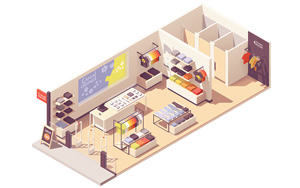 by Lizzie Weakley
by Lizzie Weakley
Brick and mortar is still a force in the market. Customers don’t always want to wait for UPS to drop products on their doorsteps. Instead, they may want to go out and shop in a public space.
However, with such fierce competition from online retailers, business owners need to use some strategy. If you want to succeed, you need to avoid certain disastrous pitfalls that can drive away consumers. Below are five such mistakes indie retailers should avoid when designing and building a new store location.
Choosing the Wrong Lighting
Installing the wrong lighting can be a huge mistake. The lighting should be bright enough to allow consumers to see around your store and to provide atmosphere. However, you also need the proper lighting to make your products look good. Certain products and consumer goods simply require different kinds of lighting. Adding spotlights on certain displays around the room can put extra emphasis on certain products.
Selecting the Wrong Shelving
Similarly, retailers need to select the right shelving. Certain kinds of shelving aren’t designed with consumers in mind. They may be too high for consumers to reach, or they may not be designed for the products you sell. The wrong shelving could even cause dangerous accidents and lead to lawsuits. Investigate different kinds of shelving like wire shelving units that may be appropriate for certain products.
Not Designing the Layout to Maximize Profit
The basic layout that consumers follow when moving through your store matters a great deal. If they can find what they want right away, you’ve made a mistake. Instead, more common purchases should be placed further back in the store so that consumers will pass other products that they may be inclined to buy as add-on purchases.
Not Giving Your Store an Aesthetic Theme
The aesthetics of a building can do a whole lot to create the mood people feel while inside. The feeling of a giant warehouse, for example, may produce uneasiness while shopping. Instead, try to give your store a pleasant theme that may enhance the shopping experience. An old world market, for example, may be an excellent choice for a grocery store. Small boutiques can also be decorated with warm, farmhouse decor to give a small shop feeling.
Getting the Location Wrong
Another thing that can make or break a store is its general location. Being on the wrong street or on the wrong side of town can decimate your profit potential. Stores should be located in a busy location where potential customers are always passing. Make sure to do a lot of research when determining where to locate your new store and weigh that data against other factors like cost.
Overall, a building is more than just a building for a retail business. Put a lot of thought into how you design and build your new store because the choices you make can have a huge impact on your ability to make a profit.
